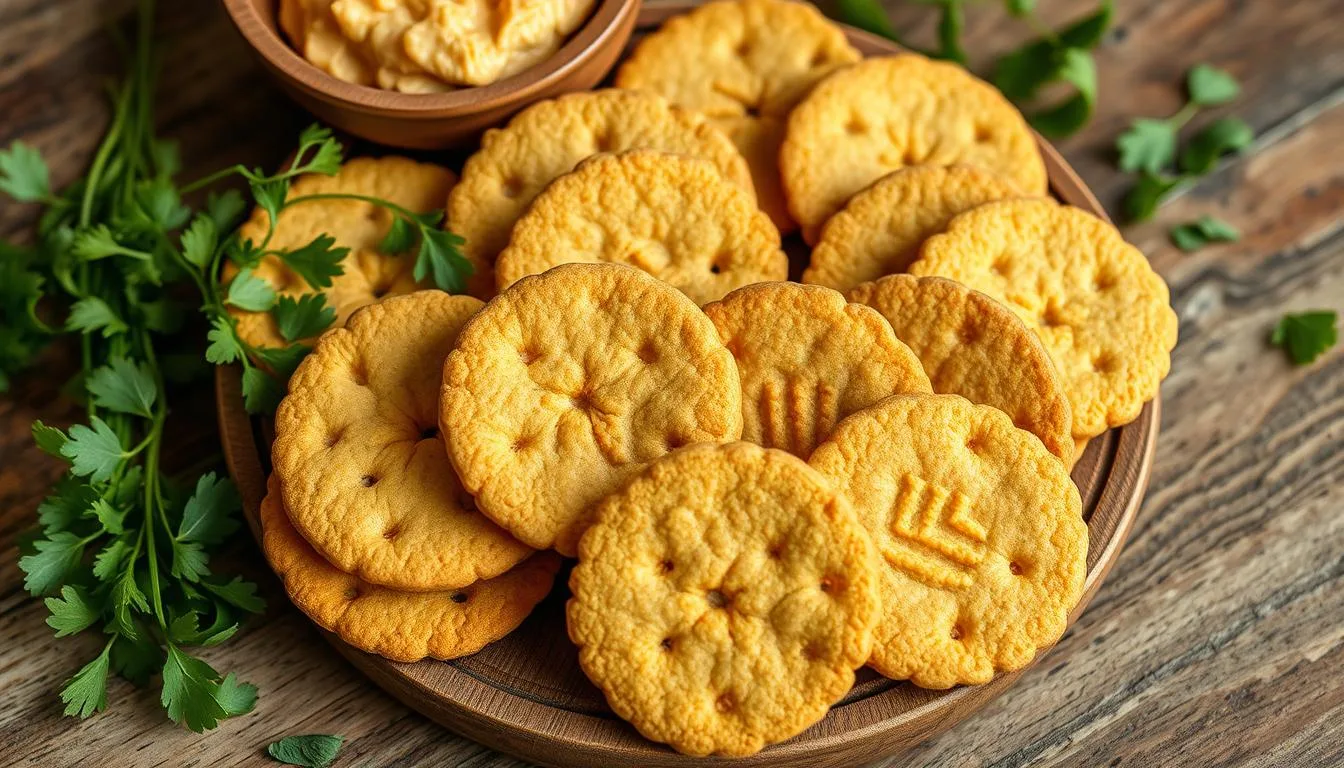Have you ever thought about how chickpea flour can make delicious gluten and grain-free crackers? I’m excited to share a recipe that’s perfect for snack lovers and those with dietary needs. These homemade crackers are a favorite in my kitchen and are easy to make.
Whether you’re looking for gluten-free baking or simple gluten-free recipes, this chickpea flour cracker recipe is for you.
Key Takeaways
- Chickpea flour is the main ingredient for gluten and grain-free crackers.
- This recipe caters to a variety of dietary preferences.
- Chickpea flour provides a nutritious alternative to traditional cracker recipes.
- Making these crackers is a straightforward and enjoyable process.
- These homemade snacks can be paired with various dips and spreads.
- They are high in protein and fiber, making them a healthy choice.
Table of Contents
Why I Love Making Chickpea Flour Crackers
Making homemade crackers with chickpea flour is now a top favorite in my kitchen. They taste great and are perfect for those who need gluten-free snacks. Their crunchy texture and special flavor make them great for any time.
A Delicious Snack Option for Everyone
Chickpea flour crackers are loved by many. They’re great for anyone who needs a healthy snack or just wants something tasty. Kids and adults both enjoy them, whether as a snack or with a meal.
Perfect for Various Diets
These crackers are great for many diets. Vegans and vegetarians get important nutrients without losing flavor. People trying to avoid gluten or grains find them a tasty option. Chickpea flour’s versatility makes these snacks a smart choice for any diet.
The Benefits of Chickpea Flour
Chickpea flour is a great choice for gluten free recipes. It’s full of nutrients that make food taste better and help you stay healthy. Let’s look at why chickpea flour is so good for cooking.
High in Protein and Fiber
Chickpea flour has lots of protein and fiber. This makes it perfect for healthy snacks. The protein helps your muscles, and the fiber is good for your digestion. Adding chickpea flour to my meals keeps me full of energy all day.
Rich in Nutrients and Antioxidants
Chickpea flour is full of vitamins and minerals that are good for you. Using chickpea flour makes cooking easy and helps you eat better.
| Nutrient | Amount per 100g |
|---|---|
| Protein | 22g |
| Fiber | 10g |
| Iron | 4.3mg |
| Magnesium | 8mg |
| Antioxidants | Present in significant amounts |
Essential Ingredients for My Crackers
Choosing the right ingredients is key for gluten free baking. Chickpea flour crackers are a tasty and healthy snack. They’re perfect for those who follow easy gluten free recipes. Here are the ingredients you need for my favorite chickpea flour recipes. I also have some tips for changing up the flavors.
List of Ingredients You’ll Need
- 1 cup chickpea flour
- 3 tablespoons olive oil
- ½ cup water
- 1 teaspoon salt
- Spices of your choice (e.g., garlic powder, onion powder, black pepper)
Gluten-Free Must-Haves
Gluten-free ingredients are a must for those with gluten sensitivities. Chickpea flour is a great base for these crackers. It’s packed with protein and fiber. Olive oil makes the crackers rich and adds to their texture.
Spices can make your crackers truly special. You can pick your favorite spices to add flavor.
Adding seeds like sesame or flaxseeds can add crunch and depth. Each ingredient is important for the final taste and texture. These crackers are not only tasty but also a great choice for a gluten-free diet.
| Ingredient | Function | Possible Substitutions |
|---|---|---|
| Chickpea Flour | Main base for the crackers | Almond flour, oat flour |
| Olive Oil | Adds moisture and richness | Coconut oil, avocado oil |
| Salt | Enhances flavor | Herbal seasoning blends |
| Spices | Adds flavor variety | Italian seasoning, cayenne pepper |
Step-by-Step Guide to Making Crackers
Making homemade crackers is fun, especially with chickpea flour. It’s a great gluten-free choice. Follow my guide to make healthy snacks that everyone will enjoy.
Preparation and Mixing
First, get your ingredients ready: chickpea flour, water, olive oil, and spices. In a bowl, mix chickpea flour, water, and oil. Keep mixing until it’s smooth and dough-like. This makes sure every cracker is tasty.
Rolling Out the Dough
Now, roll out the dough. Put it between parchment paper to stop it from sticking. This makes the crackers crispy and lets the flavors spread.
Cutting into Shapes
You can make squares or fun shapes for kids. Make sure they have room to spread in the oven.
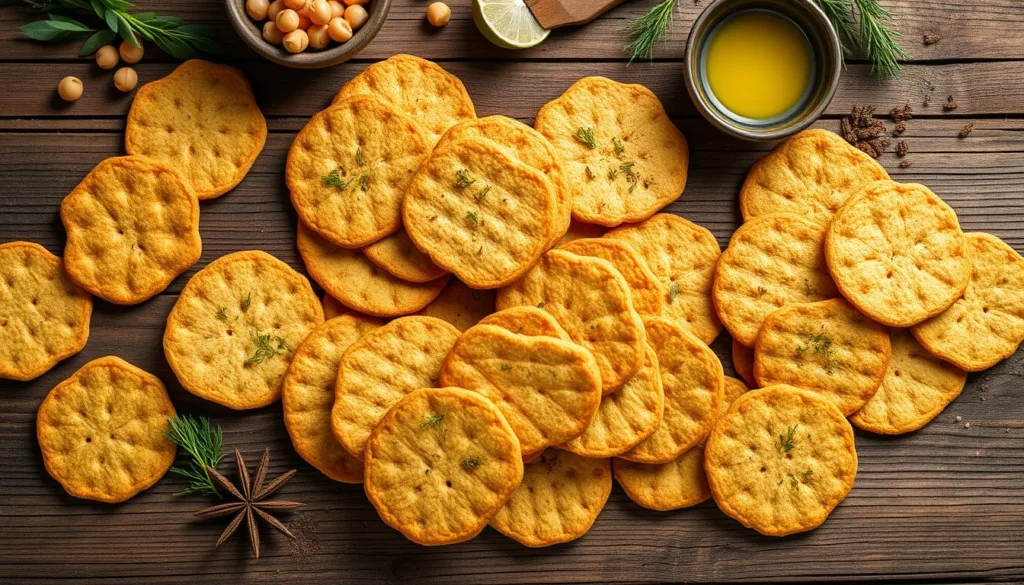
Flavor Variations to Try
Trying different flavors for my gluten free grain free crackers chickpea flour recipe makes them even better. These snacks can change with herbs, spices, or sweet things. You can make them savory or sweet, and there are lots of great options.
Herbs and Spices Add Excitement
For a savory twist, add unique herbs and spices. Here are some I like in my chickpea flour recipes:
- Rosemary: Adds a fragrant, earthy flavor.
- Cumin: Provides a warm, nutty undertone.
- Garlic powder: Offers a delicious aromatic element.
Sweet Variations for Dessert Lovers
If you love sweets, these chickpea flour crackers can be a tasty dessert. Try adding:
- Cinnamon: A classic flavor that pairs beautifully.
- Sugar: An easy way to add sweetness.
- Cocoa powder: For chocolate lover’s delight.
With these variations, your gluten free grain free crackers will never be boring. Enjoy trying different flavors to make a snack that’s perfect for any time!
Tips for Perfect Texture
Getting the right texture in my chickpea flour crackers is key for a great snack. A few tips can help you get the dough just right. This is important for gluten free baking.
Achieving the Right Consistency
The dough’s consistency is very important. It should be soft but firm. Start by adding water slowly until it’s not too wet but holds together.
If it’s too dry, add a little water at a time. This will help you get the perfect texture.
Oven Temperature Insights
The oven temperature is also crucial. Preheat it to 350°F (175°C) for even baking. This ensures the crackers get crispy on the outside and just right on the inside.
Check the crackers after 15 minutes. Turn them halfway to get even browning.
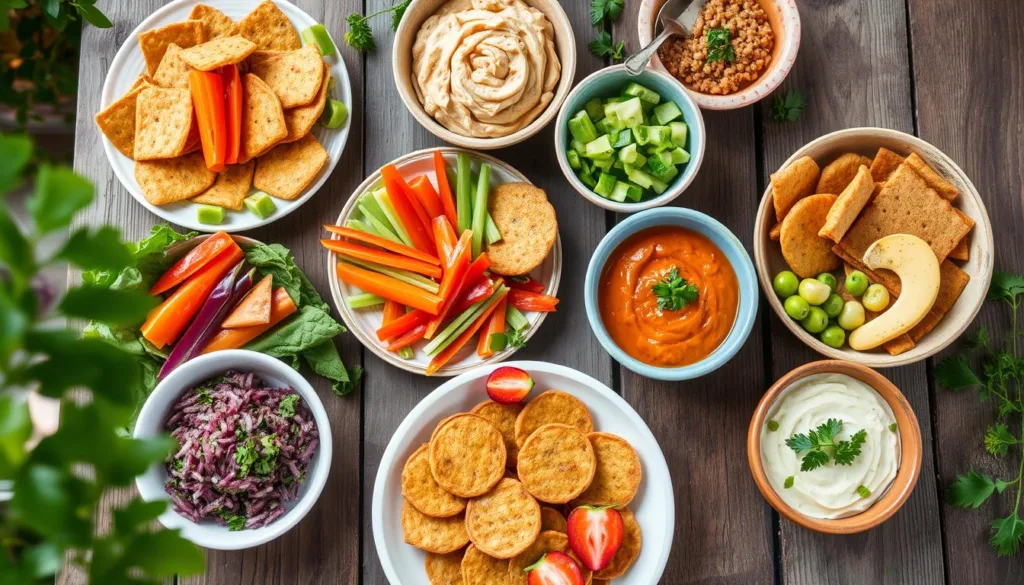
Common Mistakes to Avoid
When making chickpea flour crackers, it’s easy to make mistakes. These mistakes can ruin the taste and texture. But, knowing what to avoid can help you make tasty snacks. Here are two main mistakes to watch out for:
Overworking the Dough
One common mistake is overworking the dough. This makes the crackers tough, not what you want. Just mix the ingredients enough to combine them without overdoing it.
Not Baking Long Enough
Another mistake is not baking the crackers long enough. If they’re not cooked enough, they won’t be crunchy. Watch the baking time closely to get them crispy.
| Mistake | Effect on Crackers | Solution |
|---|---|---|
| Overworking the dough | Tough texture | Mix ingredients until just combined |
| Not baking long enough | Soft texture | Bake until crispy and golden |
By avoiding these mistakes, you can enjoy your chickpea flour crackers. They’ll be a great addition to your gluten-free recipes and a tasty treat every time.
Storage Tips for My Crackers
After baking my homemade crackers, it’s key to store them right. This keeps them fresh and crunchy. A few easy tips can help them stay tasty for longer.
How to Keep Them Fresh
Store my crackers in an airtight container once they cool. This stops moisture from making them stale.
Best Containers for Storage
Choosing the right container is important for keeping my snacks fresh. Here are some good choices:
- Glass jars with airtight lids
- Plastic containers with secure seals
- Metal tins with tight-fitting lids
Write the date on the container to remember when you made them. Proper storage lets me enjoy them longer, without losing flavor or texture.
| Container Type | Pros | Cons |
|---|---|---|
| Glass Jars | Durable and easy to clean | Can be heavy and breakable |
| Plastic Containers | Lightweight and portable | May retain odors over time |
| Metal Tins | Great for rustic presentation | Avoid if exposed to moisture |
Serving Suggestions for Chickpea Crackers
Chickpea flour crackers are a fun canvas for toppings and dips. They add a nice crunch and match many flavors. I enjoy them with different dips for a tasty treat.
Perfect Pairings with Dips
Dips make chickpea crackers even more delicious. Here are some great pairings:
- Hummus – A classic that adds creaminess and flavor.
- Guacamole – Avocado’s buttery texture is a great contrast.
- Yogurt-Based Dips – Light and refreshing, perfect for summer.
- Spicy Salsa – Adds excitement for those who like spice.
Adding to Cheese Boards
Chickpea crackers are great on cheese boards. They offer a gluten-free option. Here’s what to include:
- Artisan Cheeses – Choose cheeses that complement each other.
- Fresh Fruits – Apples, grapes, or figs add sweetness.
- Olives and Pickles – Add savory elements for balance.
These serving ideas make my gluten-free baking more fun. Whether I’m hosting or just relaxing, these recipes make every moment special.
| Dip | Flavor Profile | Pairing Suggestion |
|---|---|---|
| Hummus | Creamy and Rich | Best with herbs sprinkled on top |
| Guacamole | Buttery and Smooth | Add lime juice for an extra zing |
| Yogurt-Based Dip | Light and Tangy | Serve chilled with sliced cucumbers |
| Spicy Salsa | Fresh and Zesty | Include diced tomatoes and onions |
Nutritional Information of My Crackers
Learning about the nutritional value of my homemade gluten free grain free crackers is exciting. These crackers not only curb my cravings but also offer key nutrients. They help make my diet more balanced.
Macronutrient Breakdown
| Nutrient | Per Serving (1 oz) |
|---|---|
| Calories | 120 |
| Protein | 5g |
| Fat | 4g |
| Carbohydrates | 18g |
| Fiber | 3g |
Health Benefits Overview
My chickpea flour recipes are packed with protein and fiber. Eating chickpeas helps me stay healthy and aids digestion. They also have antioxidants that boost my overall health and heart health.
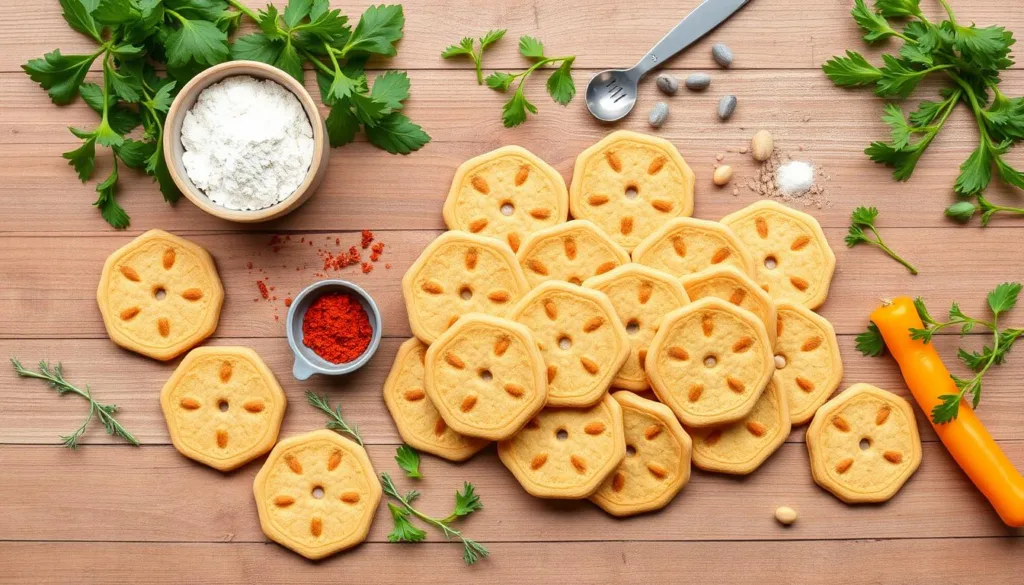
Why Go Gluten and Grain-Free?
Starting a gluten and grain-free diet can seem tough. It’s especially hard for those with celiac disease or gluten intolerance. But, it opens up a world of tasty and healthy snacks.
Understanding Dietary Restrictions
Many people must avoid gluten and grains due to health issues. Conditions like celiac disease and gluten intolerance make it necessary. Eating gluten can cause serious stomach problems and other health issues.
Exploring Health Benefits
My diet change has made a big difference. I feel better and have more energy. Healthy snacks keep me satisfied and happy.
| Dietary Aspect | Gluten-Free | Grain-Free |
|---|---|---|
| Common Restrictions | Celiac disease, gluten intolerance | Celiac disease, grain intolerances |
| Possible Benefits | Improved digestion, less inflammation | Lower carb intake, increased energy |
| Healthy Snack Ideas | Vegetable sticks with dip, chickpea flour crackers | Nuts and seeds, meat jerky |
Fun Facts About Chickpeas
They were first grown in the Mediterranean and Middle East. Now, they are a key part of many diets, including gluten-free ones.
Their use in many recipes shows their great taste and health benefits.
Their Origin and History
They first grew in the Middle East over 7,000 years ago. The Romans and Greeks loved them, using them in their meals.
As trade grew, so did the use of chickpeas. Now, they are found in many cuisines around the world. They fit well in Mediterranean dishes and Indian curries.
Nutritional Profile
Chickpeas are packed with protein and fiber. They also have important vitamins and minerals like folate, iron, and magnesium. These nutrients help keep you healthy.
They are great for those who can’t eat gluten but still want tasty, filling meals. Using chickpea flour in my recipes lets me make yummy snacks like chickpea flour crackers. It’s a win-win for my diet.
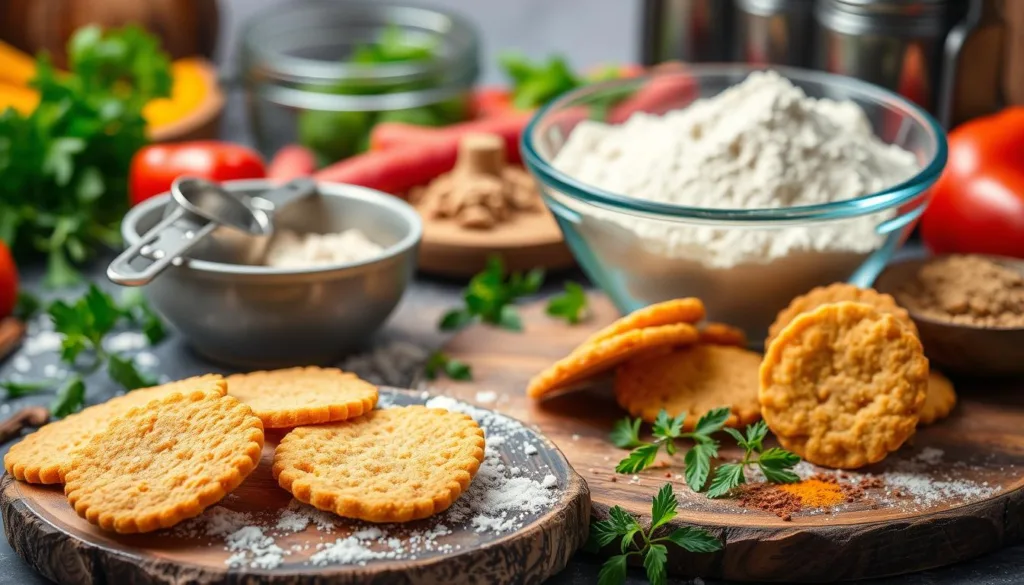
Recipes to Pair with Chickpea Flour Crackers
Finding the perfect snack to go with chickpea flour crackers is exciting. I enjoy trying different dips and soups to make these snacks even better. Here are some tasty options that will highlight the crackers.
Delicious Dips and Spreads
To make my snacks even healthier, I make these tasty dips:
- Roasted Red Pepper Hummus: This hummus is rich and smoky. It goes great with the crunchy chickpea flour crackers.
- Creamy Tzatziki: A cool yogurt dip with cucumber and herbs. It’s perfect for hot summer days.
- Avocado Lime Dip: This dip is creamy avocado mixed with lime. It’s a nice contrast to the crunchy crackers.
Soups that Complement the Crackers
Soups are also great with chickpea flour crackers. Here are a couple of my favorites:
- Tomato Basil Soup: A classic choice that’s comforting. The crackers make a tasty dip.
- Lentil Soup: Full of protein and flavor. It makes a filling meal with the crackers.
These recipes not only match the texture and taste of chickpea flour crackers. They also make for a balanced snack time. Try these pairings and see how they can make your meals even better!
My Journey to Gluten-Free Eating
Starting a gluten-free diet was a big change for me. At first, giving up pasta, bread, and sweets seemed hard. But, I found ways to adapt and enjoy tasty meals.
Challenges I Faced
One big challenge was eating out or at parties. Gluten-free options were hard to find. I also had trouble finding recipes that tasted good and fit my diet.
Planning meals and checking ingredients was tough. It felt like a big task to keep my diet gluten-free.
What I Learned Along the Way
Despite the hard parts, I learned a lot. I started trying new recipes that were easy and fun. Using flours like almond or chickpea flour made cooking exciting.
Meal prep became key for me. It helped me stay organized and keep my meals interesting. This journey has changed how I see food and encouraged me to try new recipes.
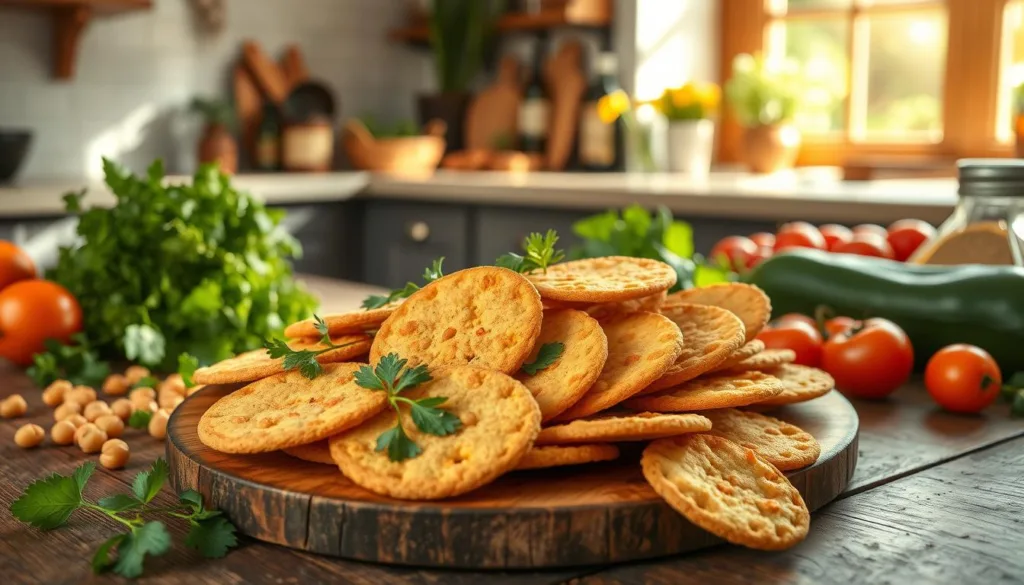
Community and Support for Gluten-Free Living
Living gluten-free is more than just changing your diet. It’s about finding a supportive community that gets it. Connecting with others who eat gluten-free is key. You can find them online, on social media, or at local events.
These connections let you share recipes and healthy snack ideas. They also offer encouragement. Knowing you’re not alone makes the journey more fun.
Connecting with Others
Being part of gluten-free communities can really help your baking. You learn new things and make friends. Many groups have meet-ups or share recipes.
Sharing your own stories, good and bad, makes you feel part of something special. It adds joy to your gluten-free life.
Resources for Continuous Learning
There are many resources for gluten-free living. Cookbooks, blogs, and classes can teach you a lot. They help you find new recipes and techniques.
Using these resources keeps your meals exciting and satisfying. Being part of these communities and learning from them is key to enjoying gluten-free cooking.
Seasonal food – Breakfast – Lunch – Dinner

